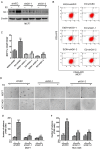Estrogen promotes stemness and invasiveness of ER-positive breast cancer cells through Gli1 activation
- PMID: 24889938
- PMCID: PMC4057898
- DOI: 10.1186/1476-4598-13-137
Estrogen promotes stemness and invasiveness of ER-positive breast cancer cells through Gli1 activation
Abstract
Background: Although long-term estrogen (E2) exposure is associated with increased breast cancer (BC) risk, and E2 appears to sustain growth of BC cells that express functional estrogen receptors (ERs), its role in promoting BC stem cells (CSCs) remains unclear. Considering that Gli1, part of the Sonic hedgehog (Shh) developmental pathway, has been shown to mediate CSCs, we investigated whether E2 and Gli1 could promote CSCs and epithelial-mesenchymal transition (EMT) in ER+ BC cell lines.
Methods: We knocked down Gli1 in several BC cells using a doxycycline-controlled vector, and compared Gli1-knockdown cells and Gli1+ cells in behavior and expression of ER, Gli1, ALDH1 (BC-CSC marker), Shh, Ptch1 (Shh receptor) and SOX2, Nanog and Bmi-1 (CSC-associated transcriptions factors), using PCR; tissue microarrays, western blot; chromatin immunoprecipitation q-PCR, confocal immunofluorescence microscopy; fluorescence-activated cell sorting; annexin-flow cytometry (for apoptosis); mammosphere culture; and colony formation, immunohistochemistry, Matrigel and wound-scratch assays.
Results: Both mRNA and protein expressions of ER correlated with those of Gli1 and ALDH1. E2 induced Gli1 expression only in ER+ BC cells. E2 promoted CSC renewal, invasiveness and EMT in ER+/Gli1+ cells but not in Gli1-knockdown cells.
Conclusions: Our results indicate that estrogen acts via Gli1 to promote CSC development and EMT in ER+ BC cells. These findings also imply that Gli1 mediates cancer stem cells, and thus could be a target of a novel treatment for ER+ breast cancer.
Figures









Similar articles
-
Hyaluronan-CD44v3 interaction with Oct4-Sox2-Nanog promotes miR-302 expression leading to self-renewal, clonal formation, and cisplatin resistance in cancer stem cells from head and neck squamous cell carcinoma.J Biol Chem. 2012 Sep 21;287(39):32800-24. doi: 10.1074/jbc.M111.308528. Epub 2012 Jul 30. J Biol Chem. 2012. PMID: 22847005 Free PMC article.
-
Different Effects of BORIS/CTCFL on Stemness Gene Expression, Sphere Formation and Cell Survival in Epithelial Cancer Stem Cells.PLoS One. 2015 Jul 17;10(7):e0132977. doi: 10.1371/journal.pone.0132977. eCollection 2015. PLoS One. 2015. PMID: 26185996 Free PMC article.
-
NPV-LDE-225 (Erismodegib) inhibits epithelial mesenchymal transition and self-renewal of glioblastoma initiating cells by regulating miR-21, miR-128, and miR-200.Neuro Oncol. 2013 Jun;15(6):691-706. doi: 10.1093/neuonc/not011. Epub 2013 Mar 12. Neuro Oncol. 2013. PMID: 23482671 Free PMC article.
-
Molecular Mechanisms of Dietary Compounds in Cancer Stem Cells from Solid Tumors: Insights into Colorectal, Breast, and Prostate Cancer.Int J Mol Sci. 2025 Jan 13;26(2):631. doi: 10.3390/ijms26020631. Int J Mol Sci. 2025. PMID: 39859345 Free PMC article. Review.
-
The Significance of Aldehyde Dehydrogenase 1 in Cancers.Int J Mol Sci. 2024 Dec 30;26(1):251. doi: 10.3390/ijms26010251. Int J Mol Sci. 2024. PMID: 39796106 Free PMC article. Review.
Cited by
-
Advances in Biomarkers and Endogenous Regulation of Breast Cancer Stem Cells.Cells. 2022 Sep 20;11(19):2941. doi: 10.3390/cells11192941. Cells. 2022. PMID: 36230903 Free PMC article. Review.
-
Abnormally elevated USP37 expression in breast cancer stem cells regulates stemness, epithelial-mesenchymal transition and cisplatin sensitivity.J Exp Clin Cancer Res. 2018 Nov 27;37(1):287. doi: 10.1186/s13046-018-0934-9. J Exp Clin Cancer Res. 2018. PMID: 30482232 Free PMC article.
-
Cellular Plasticity in Breast Cancer Progression and Therapy.Front Mol Biosci. 2020 Apr 24;7:72. doi: 10.3389/fmolb.2020.00072. eCollection 2020. Front Mol Biosci. 2020. PMID: 32391382 Free PMC article. Review.
-
Flexible modeling of regulatory networks improves transcription factor activity estimation.NPJ Syst Biol Appl. 2024 May 28;10(1):58. doi: 10.1038/s41540-024-00386-w. NPJ Syst Biol Appl. 2024. PMID: 38806476 Free PMC article.
-
ABCB5-ZEB1 Axis Promotes Invasion and Metastasis in Breast Cancer Cells.Oncol Res. 2017 Mar 13;25(3):305-316. doi: 10.3727/096504016X14734149559061. Oncol Res. 2017. PMID: 28281973 Free PMC article.
References
Publication types
MeSH terms
Substances
LinkOut - more resources
Full Text Sources
Other Literature Sources
Medical
Research Materials
Miscellaneous

